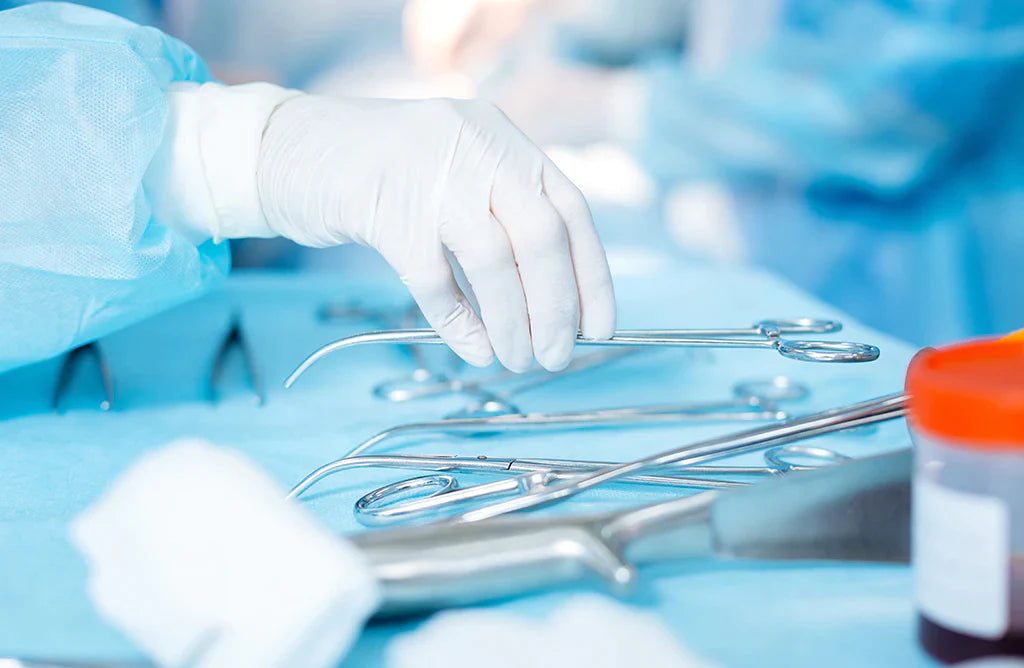What is Gastric Band Surgery?
Gastric Band Surgery, also known as the lap band, is a type of Weight Loss Surgery to help weight loss. It requires placing a silicone band around the top part of the stomach and attaching a tube to the band to reduce stomach size and food intake.
How much weight will you lose after Lap Band Surgery?
The average weight loss after Lap Band Surgery is 50% of excess weight. Take your current weight and subtract your ideal weight (or weight at a healthy BMI) to calculate your excess weight. However, results vary for everyone and are dependent on food and lifestyle choices after the intervention.
Who are candidates for the Gastric Band system?
Generally, those with weight-related medical conditions such as diabetes or high blood pressure and have a 35-45 BMI to qualify for gastric band surgery. The surgery is indicated for adults only and is not performed on those under 18 years old.
Those exploring Gastric Band eligibilities need to demonstrate an understanding of the surgery procedure and adhere to the necessary lifestyle changes to succeed in this surgery.

How to prepare for Gastric Band Surgery?
Following Gastric Band Surgery, it's imperative to make significant changes in eating habits and dietary choices. The pre-op diet for Gastric Band Surgery is the beginning of the changes that will need to be followed to achieve the best results for this surgery long term.
Many Bariatric Surgeons will place patients on a calorie-restricted diet or recommend Bariatric liquid protein supplements before a Gastric Banding Surgery with avoiding refined sugars and reducing carbohydrates, saturated fat and dietary fat intake.
A pre-op diet may be recommended 2-3 months before surgery to boost weight loss. A complete liquid protein diet will occur two weeks before surgery to prepare a patient's body for the transition following Gastric Band Surgery and reduce the liver's size to allow your surgeon to safely perform the surgery.
The Pre-Gastric Band diet may seem extreme; however, it does prepare you and your body for the necessary changes it will experience following the surgery for safe and effective results.

Surgery Procedure
The removal of a Lap-Band is a surgical procedure done under complete general anaesthesia, taking approximately 1-2 hours to perform using a laparoscopic technique. Most patients get their band removed due to:
- Insufficient weight loss (less than 25% of excess weight)
- Complications such as band erosion, lack of adherence to portion control or "slipping" of the band
Luckily, the removal of the Lap-Band is quite a straightforward procedure. The options available are to convert to a gastric sleeve or gastric bypass to continue and improve your long-term weight loss and health.

Gastric Band Surgery Nutritional Risks and Complications
Any surgery comes with its risks. It's crucial to follow everything your Bariatric team has advised you to do in preparation for your surgery to contribute to your safety during and throughout your recovery.
Gastric Band Surgery does not impact nutrient absorption, but potential nutrient deficiencies can occur through;
- Poor eating behaviour
- Low eating behaviour
- Altered food tolerance
- Restricted portion size
After Gastric Band, Bariatric supplement selection can be recommended depending on your pre-operative status and the findings during long-term nutrition monitoring.
Your persistence to initiate and continue lifestyle changes partnered with support from your Bariatric team will ensure a successful weight loss journey after surgery. In addition, being noncompliant with bariatric dietary guidelines can bring long-term health problems.
Getting your bloods checked regularly will help avoid impacting your quality of life. If you have any issues that concern you or feel unwell, always check in with your team.

RECOVERY
After your Gastric Band Surgery, your recovery will be in the hospital for a short stay, followed by recovery time at home afterwards. Gastric Band Surgery is minimally invasive as its performed laparoscopically (keyhole). The surgeon will make small cuts performed under general anaesthetic and will probably involve 2-3 days of hospital stay.
Understanding what to expect regarding your Gastric Band recovery is an essential factor in your weight loss journey. Gastric Lap-Band recovery time varies for everyone; however, on average takes 4-6 weeks following the installation of the band. Ensure you follow all instructions that your Bariatric team has set for you before and after the procedure.
You'll be able to have liquids in the first few weeks after surgery. You'll move to pureed and soft food before recommencing to solid food. Your Bariatric surgeon or dietitian will discuss your diet and exercise plan to make for a healthier lifestyle to help you reach your weight loss goals. The diet plan will involve recommendations regarding your food choices and the amount you should be consuming - this will include eating smaller meals, as your new stomach can only hold a small amount of food at one time.
It's crucial to 'listen to your new stomach' and how you feel when you eat different foods. Your Bariatric surgeon or dietitian will support you with any problems you experience and advise tweaking your diet and eating habits.
During your recovery time, you will need to attend follow up appointments with Gastric Band adjustments as Gastric Bands need to be adjusted 4-6 times in the first year after surgery. It frequently takes many adjustments to find the right level of restriction suitable for you. Additionally, attending your regular hospital appointments, ensuring everything is going well, staying on track, and having adequate nutrition.
It’s crucial to follow your post-surgery plan precisely to prevent any risks or complications from introducing each stage appropriately. It is best if you take it slowly for a while. Once you're discharged from the hospital, your body has undergone significant changes; therefore, it needs to heal physically and adjust to the new nutrition changes. Your dietitian will provide you with daily water and protein intake goals; meeting those goals every day will maintain good health long-term.
The removal of the Lap-Band is quite a straightforward procedure. The options available are to convert to a Gastric Sleeve or Gastric Bypass to continue and improve your long-term weight loss and health. The Gastric Band removal recovery time can vary for every individual within at least 3-4 weeks or until you are comfortable.
Dietary Guidelines After Weight Loss Surgery
After your Gastric Band Surgery, you must go through four stages,slowly progressing from liquids to solid food. It is crucial to allow your band to settle into the correct position. At first, you will feel full quite quickly and do not feel hungry; adjust by eating minimal amounts. Over the coming weeks, you will be able to eat three small meals a day. Your meals after Lap-Band surgery will need to include mostlyprotein, fruits, vegetables, and whole grains to help your body get the nutrients it needswhile losing weight quickly.
| Stage | Diet Type | Time | Definition |
|---|---|---|---|
| 1 | Liquid Diet | 1-2 weeks after surgery | Easily sipped through a straw. |
| 2 | Pureed Foods | 2-4 weeks | Like an applesauce consistency. |
| 3 | Soft Foods | 4-6 weeks | Can be mashed with a fork. |
| 4 | Solid Foods | 6-8 weeks | All textures with low in carbs, fats and sugar. |
Exercise Options After Lap-Band
Your Lap-Band Surgery aftercare will be working on improving your health and lifestyle.
Exercise is an essential part of the ongoing weight loss journey as it works hand-in-hand with Gastric Band Surgery.
As you recover from your recent Gastric Band Surgery, you should consult your Bariatric team before starting an exercise regimen. Doing so will help ensure you are physically ready for the necessary executions and perform the exercises at an appropriate level of your physical health.
Several kinds of exercises are recommended at various stages of recovery after Gastric Band Surgery:

Walking
After undergoing Lap-Band Surgery, you can usually start walking around your home within a few days of surgery. Walking for a few minutes every few hours is an excellent place to start. The simple act of walking can stimulate muscles and burn calories.

Aerobic Training
Most patients can do light aerobic workouts during the second month of post-surgery recovery. Aerobics exercises offer resistance to start building muscle mass and, at the same time, allow you to elevate your heart rate for a sustained period.

Light Weight Training
You may engage in light weight training during the third month of recovery, with weights slowly increasing. Remember to avoid strenuous exercises that strain the abdominal area as you recover.
It is best to introduce exercise carefully and regularly as you recover from surgery. Pushing your body to do something not yet ready for will put you at risk of an injury or complications that will make it challenging to continue your progress.
Advantages & Disadvantages
The primary goal of any Weight Loss Surgery is weight loss. The Gastric Banding advantages and disadvantages can differ for every individual and experience. You can quickly experience the benefits of Lap-Band Surgery entail, which are:
- Decreases the amount of food the stomach can hold
- Promotes excess weight loss of approximately 40-50%
- No cutting of the stomach or rerouting of the intestines
- Improves your quality of life
All surgeries, whether elective or necessary, carry a risk of disadvantages.
The disadvantages of Gastric Band Surgery are:
- A foreign device will remain in the body.
- A small percentage of patients can result in possible band slippage or band erosion in the stomach.
- If the patient overeats, it can result in dilation of the esophagus.
- Follow strict adherence to the post-operative diet and follow-up visits.
However, the advantages of undergoing gastric band surgery far outweigh the Lap-Band problems years after surgery.
Gastric Band Surgery Frequently Asked Questions
-
What does a Gastric Band do?
A Gastric Band works by limiting the amount of food to fill your pouch to decrease caloric intake / overeating. Therefore, eating large portions is not needed to be satisfied. The surgeon will place a tight, adjustable band around the top part of the stomach to separate the organ, which sends a signal to your brain that you are satisfied.
-
What is the cost of Lap-Band Surgery?
The total Gastric Band Surgery cost may comprise the Medicare rebate, a private health fund rebate, and an out-of-pocket expense.
-
What is the average cost of Gastric Band Surgery?
A few factors are included in determining Gastric Band costs in Australia. The associated fees of Gastric Band Surgery cost Australia is collected of many elements, which include:
- Hospital charges for stay and operating theatre
- Equipment used during operation: the Gastric Band itself
- Fees associated with the surgeon, surgeon assistants, and anaesthetist
Australia can vary from practice to practice when deciding who to engage with for your Gastric Band Surgery. Ensure you are looking for management and after-care support and frequent check-ups to ensure everything is operating smoothly. It would be more beneficial to acquire a dietitian, psychologist and exercise physiologist who will support you through your journey. So, perhaps spending a bit more will help you in the long run.
-
What is the difference between Lap-Band and Sleeve?
Lap-Band and Gastric Sleeve Surgery both alter the stomach to hold less food. The Lap-Band is purely restrictive and can be reversed. The Gastric Sleeve is permanent and metabolic; it brings hormonal changes to encourage feelings of reduced hunger and increased satiety.
A Lap-Band is a surgery that uses an adjustable Gastric Band device to limit the stomach and reduce food consumption. It can be inflated or deflated with saline injections through a small port underneath the skin. The Gastric Band does not involve cutting or stapling the stomach; therefore, the digestion is unchanged. If you wish to have your gastric band taken out, you can do so.
Gastric Sleeve Surgery reshapes the stomach by the surgeon removing a large part of the stomach. The remaining part of the stomach is shaped like a tube or Sleeve. As it requires cutting and suturing the stomach, recovery time may be longer than a lap band surgery. Gastric Sleeve is a permanent weight loss intervention.
-
What insurance covers Lap-Band Surgery?
Lap-Band Surgery is classified as elective surgery; therefore, Medicare does not fully cover it. However, public cases are available in some cases where certain criteria are met. Those with private health insurance should have approximately 85% of the Lap-Band Surgery cost covered by their health insurance policy, depending on what country you will have your surgery in.
The insurance coverage of Lap-Band Surgery varies depending on your policy. If your insurance policy covers weight loss surgery and you meet the qualification requirements, most plans will pay for your Lap-Band Surgery.
-
How does Gastric Band work?
Gastric Band Surgery works using a laparoscopic (keyhole) surgery with the band placed around the stomach's upper part to create a small pouch. It then creates a constriction at the band level, which slows down the passage of food through the stomach and reduces the amount of food eaten in one sitting.
-
How safe is Lap-Band Surgery?
Lap-Band Surgery is a safe procedure. Those undergoing gastric band surgery can take comfort in being conducted safely. Lap-Band Surgery has been well researched and developed with the patients' safety in mind.